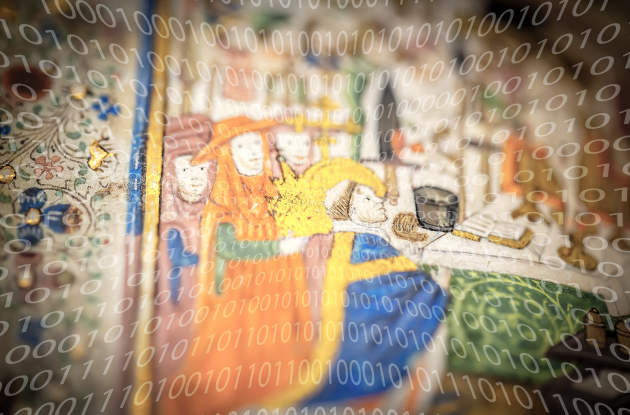Strategy for digitisation of physical cultural heritage
Royal Danish Library's strategy for digitising the physical cultural heritage for the period 2020-2023.

Photo: Annemette Kuhlmann og Helle Brünnich Pedersen
Purpose of digitisation of the physical cultural heritage
Royal Danish Library is Denmark's national library. It is our task to collect, preserve and make available the physical collections and ensure that the users of the library can make the best possible use of this important part of our common cultural heritage.
Digitisation of physical works and collections plays a central role in this utilisation. Not only does digitisation make it possible to provide online access to digital versions of the collections. It also elevates the information from the physical works into a digital knowledge universe, thus opening up completely new ways of searching for, exploring and combining the cultural heritage for the benefit and enjoyment of education and research, information and experience.
Digitisation of cultural heritage also plays a significant role in ensuring the preservation of information on physical material that is threatened by degradation or physical media threatened by technological obsolescence. Similarly, digitisation can protect vulnerable physical collections from wear and tear and theft by making digital copies available. Finally, digitisation can ensure that at least one digital copy is available should a work be lost as a result of fire, flood or other disaster.
Today, the physical collections worthy of preservation fill more than 100 kilometres of shelves in the library's storage rooms, and they continue to grow. The collections consist of books, magazines, small prints, newspapers, archives, sheet music, maps, pictures, photographs, audio and video recordings, and so on. These cultural heritage collections have been collected through the Danish Legal Deposit Act, donations and purchases. Yet only a small proportion of the collections worthy of preservation are digitised and available online.
Users are increasingly expecting to be able to use the library's collections digitally. The goal of our cultural heritage digitisation is therefore to increase the supply and availability of the collections that users demand and make it faster to answer queries and deliver on digitisation jobs. At the same time, digitisation must ensure that the collection structure supports our other dissemination and preservation tasks.
We operate with a multi-year digitisation plan and the following digitisation programmes:
- Royal Danish Library's Treasures - digitisations of particularly valuable works and collections
- Order & Use - user-driven digitisations
- Discover & Explore - curator-led digitisations oriented around the dissemination of collections
- Protect & Preserve - curatorialised digitisations primarily aimed at preserving collections
Cultural heritage digitisation must not be confused with our standard copy service, where users can make copies of physical works that are not covered by our preservation obligation.
Strategic objectives
The scope of the library's collections and the demand for digitised material in relation to the resources we have available means that we are constantly working on a hard prioritisation of which collections we select for digitisation. At the same time, we have an ongoing focus on streamlining the digitisation processes, and the way the digitisation work is organised. Finally, we are working to increase the amount of resources for digitisation through the improvement of existing business models and the development of new ones.
The overall strategic objectives are:
1. Prioritisation and selection of cultural heritage for digitisation
In order to increase the usability of the already digitised collections and create a greater whole in the collection structure, we will prioritise the systematic digitisation of legal deposit collections:
- Chronological digitisation of 17th century books and exploration of possibilities for subsequent digitisation of 18th and 19th century books
- Thematic digitisation of newspapers and general collection development
- Preservation digitisation of endangered AV media, including audio and video recordings on magnetic tape
In addition, we will prioritise the digitisation of the most significant and in-demand museum collections, partly to avoid wear and tear of the works as a result of use in, for example, a reading room:
- Particularly valuable works that may only be used in the specially secured part of the Research reading room while observing the library's policy for the protection of copyright and personal data
- Other significant cultural-historical works, such as photographs by royal court photographer Peter Elfelt
2. Consolidation of cross-institutional workflows and systems for managing the digitisation processes
To enhance efficiency and increase digitisation capacity, we will strengthen the integration between the systems that manage, preserve and provide access to the digitised material, and enhance efficiency of cross-institutional workflows and processes. Initially by implementing a workflow management system for handling cross-institutional digitisation processes. We will also strengthen the automatic generation of metadata during digitisation in order to make it easier for the users to search the collections, while simultaneously enabling us to optimise our collection management.
3. Further development of business models for cultural heritage digitisation
In order to create greater scope for the digitisation of the cultural heritage, we will streamline and promote the collaboration with external partners and customers around digitisation projects. In addition, we will map our services aimed at cultural heritage digitisation, from standard services such as digitisation of Danish books on demand to more specialised services such as multispectral digitisation and analysis. As part of the mapping, we will study the costs of the individual services and their usefulness in relation to the users and the collection management. Against this background, we will further develop the most appropriate business models.
4. Improving communication to users about cultural heritage digitisation
To make it easier for users to utilise and order cultural heritage digitisation, we will describe and price all our digitisation services on Royal Danish Library’s website www.kb.dk, and the existing order forms must be consolidated.